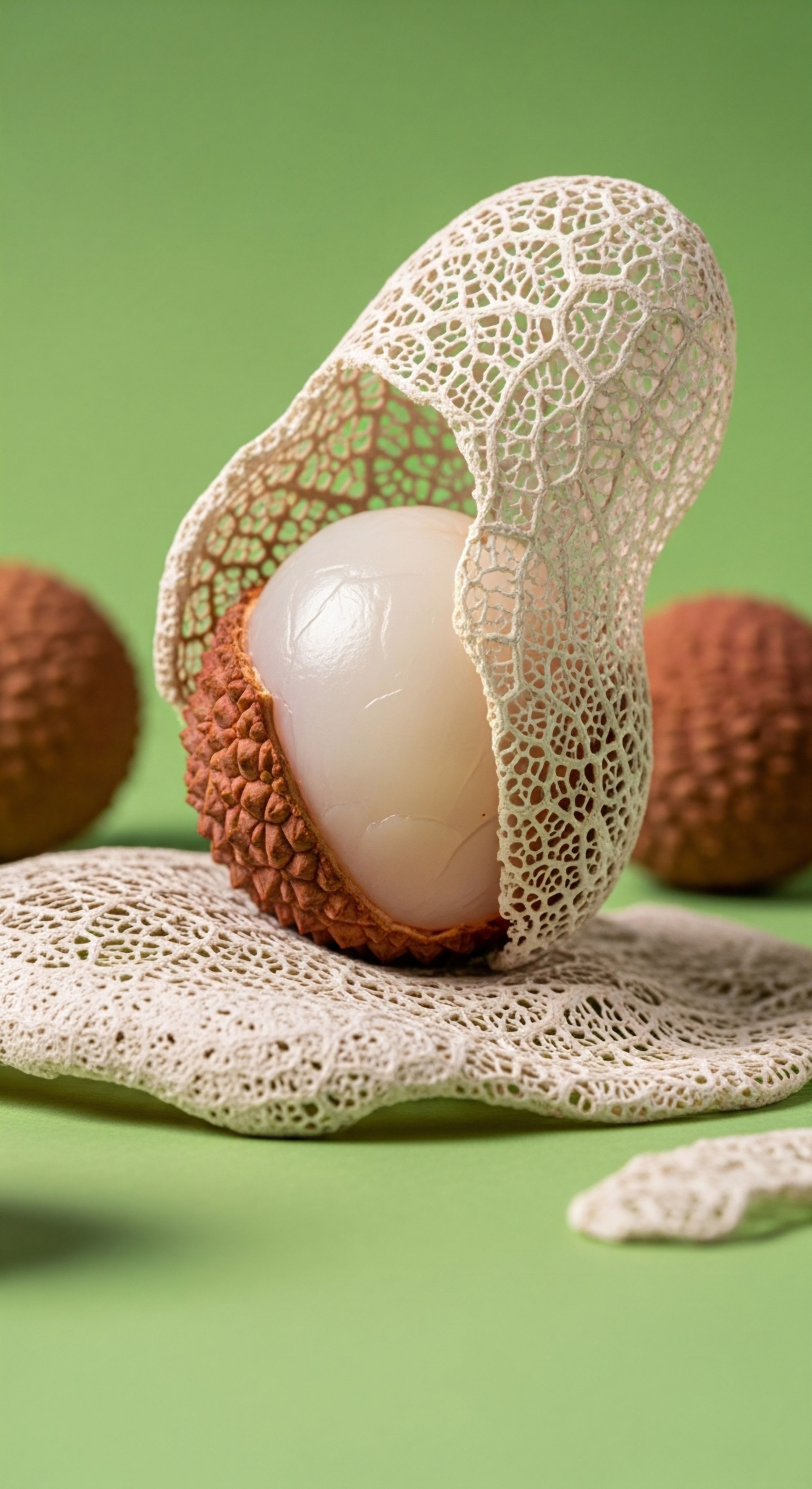

Fundamentals
You may have felt it as a subtle shift in your energy, a change in your body’s composition that diet and exercise do not seem to touch, or perhaps you have seen it as a number on a lab report that your clinician pointed out.
This experience, this sense that your internal calibration is off, is a valid and important signal from your body. It is an invitation to understand the intricate communication network that governs your vitality. Your body operates through a precise language of chemical messengers, and a key interpreter of this language is a molecule called Sex Hormone-Binding Globulin, or SHBG. Comprehending its role is a foundational step in taking deliberate control of your long-term health, particularly your cardiovascular wellness.
SHBG is a protein synthesized primarily within your liver. Its main function is to act as a transport vehicle for sex hormones, particularly testosterone and estrogen, as they travel through your bloodstream. Think of it as a specialized courier service. When a hormone is bound to SHBG, it is in transit and inactive.
Only the hormones that are “free” or unbound are biologically available to enter cells and exert their effects, influencing everything from muscle maintenance and mood to cognitive function and libido. The level of SHBG in your blood, therefore, dictates the amount of free, active hormone available to your tissues. A lower SHBG level means more free hormones, while a higher level means fewer are available for immediate use.

The Connection between SHBG and Your Heart
The concentration of SHBG in your circulation is a remarkably insightful barometer of your metabolic health. Low levels of SHBG are consistently associated with a state of metabolic distress, particularly insulin resistance. Insulin resistance occurs when your body’s cells become less responsive to the hormone insulin, which is responsible for managing blood sugar.
To compensate, your pancreas produces more and more insulin, leading to a condition of high circulating insulin levels known as hyperinsulinemia. This metabolic state is a primary driver of many cardiovascular risk factors. The liver, being a central metabolic organ, is highly sensitive to these insulin signals.
When insulin levels are chronically high, the liver receives a constant message that the body is in an energy-surplus, high-stress state. One of its responses is to down-regulate the production of SHBG.
A low SHBG reading often serves as an early warning signal from the liver, indicating underlying metabolic dysfunction long before other markers become abnormal.
This is why a low SHBG level is frequently observed alongside a cluster of conditions collectively known as metabolic syndrome. These include increased blood pressure, high blood sugar, excess body fat around the waist, and abnormal cholesterol or triglyceride levels. Each of these factors independently contributes to the risk of developing cardiovascular diseases like coronary heart disease and stroke.
The SHBG level provides a window into this entire metabolic picture. A low reading suggests that the systems responsible for managing energy and inflammation are under strain, creating an internal environment conducive to cardiovascular damage.

Lifestyle as the Primary Modulator
The knowledge that SHBG levels are so closely tied to metabolic function is profoundly empowering. It means that the primary dials controlling this crucial protein are within your sphere of influence. Your daily choices regarding nutrition, physical activity, and body composition directly impact your liver’s health and your body’s insulin sensitivity.
Consequently, these choices are the most powerful tools you have to modulate your SHBG levels. By adopting interventions that reduce liver fat, decrease inflammation, and restore insulin sensitivity, you can directly encourage your liver to increase its production of SHBG.
This process is a testament to the body’s capacity for recalibration. Viewing your SHBG level as a dynamic marker that responds to your inputs transforms it from a static number on a page into a personalized guide for your wellness journey. It affirms that through conscious, targeted lifestyle strategies, you can fundamentally alter your internal biochemistry, reduce your cardiovascular risk, and build a more resilient physiological foundation for the future.


Intermediate
To truly grasp how lifestyle interventions can effectively modulate SHBG, we must look deeper into the organ responsible for its creation ∞ the liver. The liver is the body’s master metabolic clearinghouse, performing hundreds of essential functions. Its ability to synthesize SHBG is directly tied to its overall health.
When the liver is under metabolic strain, particularly from the accumulation of fat within its cells ∞ a condition known as non-alcoholic fatty liver disease (NAFLD) ∞ its intricate functions become compromised. NAFLD is not an isolated condition; it is the hepatic manifestation of systemic metabolic dysfunction, driven largely by diet and lifestyle.
A fatty liver is an inflamed and insulin-resistant liver. This environment is biochemically suppressive to the genes responsible for SHBG production. The accumulation of triglycerides within hepatocytes sends a signal of energy overload, which in turn disrupts the delicate machinery of protein synthesis.
Therefore, any effective strategy to raise SHBG must begin with improving the health of the liver. This involves interventions that reduce the fat burden on the liver, quell hepatic inflammation, and restore its sensitivity to hormonal signals. Lifestyle choices that promote weight loss, especially the reduction of visceral fat (the metabolically active fat surrounding the organs), are paramount in achieving this goal.

Insulin the Dominant Signal
Among the many signals the liver receives, the message from insulin is one of the most powerful. There exists a direct and inverse relationship between circulating insulin levels and SHBG production. When the body is insulin resistant, blood glucose is not efficiently taken up by muscle and fat cells. The pancreas responds by secreting progressively larger amounts of insulin to overcome this resistance. The resulting state of chronic hyperinsulinemia is a key factor in the suppression of SHBG.
Imagine the liver as a sophisticated control center. Insulin acts as a high-priority message related to energy storage. In a healthy state, insulin signals are intermittent, rising after a meal and falling thereafter. In a state of insulin resistance, the signal is relentless, like a constant, blaring alarm.
This continuous “emergency” signal forces the liver to prioritize tasks related to glucose and fat metabolism, while down-regulating other functions it deems less immediately critical. The production of SHBG is one of the processes that is throttled back. Improving insulin sensitivity is therefore the most direct biochemical lever we can pull to increase SHBG.
When muscle and fat cells become more responsive to insulin, the pancreas can secrete less of it, the “alarm” in the liver quiets down, and the genetic machinery for SHBG synthesis is permitted to function normally again.
Improving the body’s sensitivity to insulin directly alleviates the suppressive pressure on the liver, allowing for increased SHBG production.

Targeted Lifestyle Protocols for SHBG Modulation
Understanding the mechanisms involving the liver and insulin allows for the design of targeted lifestyle interventions. These protocols are designed to address the root causes of low SHBG ∞ excess adiposity, liver fat accumulation, and insulin resistance.

Dietary Strategies for Metabolic Recalibration
The goal of a pro-SHBG diet is to reduce the metabolic burden on the liver and pancreas. This is achieved by minimizing foods that spike blood sugar and insulin and emphasizing nutrient-dense foods that support metabolic health.
- Fiber Intake ∞ A diet rich in soluble and insoluble fiber, found in leafy greens, non-starchy vegetables, legumes, and nuts, slows the absorption of glucose, leading to a more blunted insulin response. Studies have shown a positive correlation between fiber intake and SHBG levels.
- Protein Quality ∞ Adequate protein intake is also important. Some research suggests that very low protein intake may lead to elevated SHBG, but a balanced intake from high-quality sources supports satiety and muscle mass, which is crucial for maintaining insulin sensitivity.
- Fat Composition ∞ The type of fat consumed matters. A focus on monounsaturated fats (from olive oil, avocados) and omega-3 polyunsaturated fats (from fatty fish) helps reduce inflammation. Conversely, high intake of saturated and trans fats contributes to liver fat and insulin resistance.
- Carbohydrate Management ∞ Reducing the intake of refined carbohydrates and sugar is the most critical step. These foods cause rapid spikes in blood glucose and insulin, directly contributing to the metabolic state that suppresses SHBG. A “prudent” dietary pattern, characterized by high intake of vegetables, fruits, fish, and whole grains, has been associated with higher SHBG levels in some individuals, particularly those with obesity.
| Dietary Characteristic | Pro-SHBG Dietary Pattern (Supports Higher Levels) | Low-SHBG Dietary Pattern (Suppresses Levels) |
|---|---|---|
| Carbohydrate Sources | High-fiber vegetables, legumes, limited whole grains | Refined grains, sugary beverages, processed snacks |
| Protein Sources | Lean poultry, fatty fish, plant-based proteins | Processed meats, high-fat dairy |
| Fat Sources | Olive oil, avocados, nuts, seeds, fatty fish (omega-3s) | Industrial seed oils, trans fats, excessive saturated fats |
| Overall Pattern | Low glycemic load, anti-inflammatory, nutrient-dense | High glycemic load, pro-inflammatory, calorie-dense |
| Primary Metabolic Effect | Improves insulin sensitivity, reduces liver fat | Promotes insulin resistance, increases liver fat |

Exercise Protocols for Enhanced Insulin Signaling
Physical activity is a powerful tool for improving insulin sensitivity, as it encourages muscles to take up glucose from the blood without requiring high levels of insulin. The type of exercise can have different effects.
- Resistance Training ∞ This form of exercise is particularly effective. Building more muscle mass increases the body’s storage capacity for glucose, providing a buffer against blood sugar spikes. Studies have shown that resistance training can increase SHBG levels in overweight and obese young men, even without significant weight loss, by improving body composition and glucose tolerance.
- High-Intensity Interval Training (HIIT) ∞ HIIT involves short bursts of intense effort followed by brief recovery periods. This type of training is highly efficient at improving insulin sensitivity and can be a time-effective strategy for metabolic improvement.
- Aerobic Exercise ∞ Moderate-intensity aerobic exercise, like brisk walking, cycling, or swimming, also improves cardiovascular health and insulin sensitivity. Consistency is key. A year-long program was shown to increase SHBG in sedentary men.
The combination of resistance and cardiovascular exercise provides a comprehensive approach. Resistance training builds the metabolic “engine” of muscle, while aerobic exercise improves the efficiency of the entire cardiovascular system. Together, they create a powerful, synergistic effect on metabolic health, which is then reflected in a healthier SHBG level and a reduced risk of cardiovascular disease.


Academic
A comprehensive analysis of SHBG’s role in cardiovascular health requires a descent into the molecular biology of the hepatocyte. The modulation of SHBG levels by lifestyle is not a vague systemic effect; it is the direct consequence of specific signaling pathways impinging upon the genetic machinery of the liver cell.
The central regulator in this process is a transcription factor known as Hepatocyte Nuclear Factor 4-alpha (HNF-4α). This nuclear receptor acts as a master switch for a multitude of genes involved in hepatic metabolism, and critically, it is a primary positive regulator of SHBG gene (SHBG) transcription. Research has demonstrated a strong positive correlation between the abundance of HNF-4α mRNA and SHBG mRNA in human liver samples, establishing a direct molecular link.
Therefore, the question of how lifestyle modulates SHBG becomes a question of what factors regulate HNF-4α. The answer lies in the metabolic milieu of the liver. States of insulin resistance and hepatic steatosis are associated with reduced HNF-4α expression and activity.
Chronically elevated insulin levels, a hallmark of insulin resistance, appear to exert a suppressive effect on HNF-4α, thereby inhibiting SHBG synthesis at its genetic origin. This provides a precise mechanism for the well-documented inverse relationship between fasting insulin and circulating SHBG levels. Fat accumulation within the liver itself also creates a lipotoxic environment that is detrimental to HNF-4α function, further cementing the link between NAFLD and low SHBG.

The Unifying Role of Inflammation
The modern understanding of chronic metabolic disease recognizes it as a state of chronic, low-grade inflammation. This inflammation, largely driven by excess visceral adiposity and dietary patterns rich in pro-inflammatory components, provides a unifying theory for SHBG suppression. Adipose tissue, particularly visceral fat, is not inert; it is an active endocrine organ that secretes a variety of signaling molecules, including pro-inflammatory cytokines such as Tumor Necrosis Factor-alpha (TNF-α) and Interleukin-1 beta (IL-1β).
These cytokines have been shown to directly suppress SHBG production by targeting HNF-4α. TNF-α, for instance, activates the Nuclear Factor-kappa B (NF-κB) signaling pathway in hepatocytes. Activated NF-κB then inhibits the expression of the HNF4A gene, leading to a decrease in HNF-4α protein levels.
With less HNF-4α available, transcription of the SHBG gene diminishes, and circulating SHBG levels fall. This pathway elegantly connects the dots ∞ a lifestyle promoting visceral obesity leads to a pro-inflammatory state, which in turn suppresses a key hepatic transcription factor, resulting in lower SHBG and a corresponding increase in cardiometabolic risk. Lifestyle interventions that reduce visceral fat and inflammation, such as weight loss and the adoption of an anti-inflammatory diet, work by dismantling this entire pathological cascade.
Chronic inflammation, driven by lifestyle factors, directly suppresses the genetic expression of SHBG through the inhibition of the master regulator HNF-4α.

Is SHBG a Causal Agent or a Passive Biomarker?
For decades, SHBG was viewed primarily as a passive biomarker, an indicator of underlying metabolic health but not an active participant in pathophysiology. Emerging evidence, however, is beginning to challenge this view. While much of the benefit associated with higher SHBG is undoubtedly due to the healthier metabolic state it reflects, there is a nascent line of inquiry suggesting SHBG may have direct, protective biological functions.
For example, research using equine adipose tissue explants demonstrated that the application of SHBG directly modulated lipid metabolism and reduced the expression of inflammatory mediators within the fat cells themselves. While this research is not in humans, it raises the intriguing possibility that SHBG may participate in endocrine feedback loops, directly influencing tissue function in ways we are only beginning to understand.
Furthermore, large-scale human epidemiological studies using Mendelian randomization (MR) have added significant weight to the argument for causality. MR studies use genetic variants associated with different SHBG levels as a proxy for a long-term, randomized trial.
These analyses have shown that a genetic predisposition to higher SHBG levels is causally associated with a lower risk of coronary heart disease (CHD). One major study in the UK Biobank, along with a meta-analysis of over 350,000 individuals, found that higher circulating SHBG was independently and robustly predictive of lower CHD risk in both men and women.
This genetic evidence suggests that raising SHBG is not merely a cosmetic change to a lab value but a genuinely protective intervention for the cardiovascular system.
| Study (First Author, Year) | Population | Study Type | Key Finding |
|---|---|---|---|
| Zhao, 2023 | 263,425 men and women (UK Biobank) | Prospective Cohort & Mendelian Randomization | Higher SHBG levels were independently and causally associated with a lower risk of coronary heart disease in both sexes. |
| Canepa, 2022 | 3,412 Italian adults | Cross-Sectional | Low SHBG serum levels correlated strongly with cardiovascular risk factors like diabetes, obesity, and hypertension. |
| Kahn, 2020 | Participants in the Diabetes Prevention Program | Randomized Clinical Trial | Intensive lifestyle intervention modified SHBG levels, primarily mediated by changes in adiposity. |
| Perry, 2010 | 55 human subjects undergoing hepatectomy | Human Tissue Analysis | SHBG gene expression in the liver is inversely related to insulin resistance and hepatic fat content, and positively correlated with HNF-4α expression. |
| Ding, 2009 | Two prospective cohorts of men | Prospective Cohort | Higher levels of SHBG were strongly associated with a decreased risk of developing type 2 diabetes. |

What Is the Efficacy of Lifestyle Interventions Alone?
This brings us to the central question ∞ can lifestyle interventions alone effectively modulate SHBG for cardiovascular benefit? The evidence indicates a clear and affirmative yes. Interventions focused on weight reduction, improved dietary patterns, and increased physical activity directly target the root causes of SHBG suppression ∞ hyperinsulinemia, hepatic steatosis, and systemic inflammation.
The Diabetes Prevention Program demonstrated that an intensive lifestyle intervention successfully modified SHBG levels, with the effect being largely attributable to reductions in adiposity. Resistance training protocols have also proven effective at increasing SHBG in at-risk populations.
The term “effectively,” however, requires qualification. The magnitude of the increase in SHBG is proportional to the degree of metabolic improvement. An individual with mild insulin resistance may see a substantial normalization of their SHBG with moderate lifestyle changes.
In contrast, a person with severe obesity, advanced NAFLD, and a strong genetic predisposition to low SHBG may require a more profound and sustained intervention to achieve a physiologically significant increase. For these individuals, while lifestyle changes are the absolute foundation of therapy, they may not be sufficient on their own to move SHBG into an optimal range for maximum cardiovascular protection.
In such clinical scenarios, the foundational lifestyle program may be augmented with other therapeutic protocols. The power of lifestyle interventions lies in their ability to address the fundamental biology of SHBG production. They are the most critical and indispensable component of any strategy to optimize this important marker for cardiovascular health.

References
- Zhao, Dan, et al. “Sex Hormone-Binding Globulin and Risk of Coronary Heart Disease in Men and Women.” Clinical Chemistry, vol. 69, no. 4, 2023, pp. 374-385.
- Kahn, Steven E. et al. “Circulating Sex Hormone Binding Globulin Levels Are Modified with Intensive Lifestyle Intervention, but Their Changes Did Not Independently Predict Diabetes Risk in the Diabetes Prevention Program.” Metabolism, vol. 115, 2021, p. 154441.
- Canepa, Marco, et al. “Sex Hormone-Binding Globulin and Its Association to Cardiovascular Risk Factors in an Italian Adult Population Cohort.” International Journal of Molecular Sciences, vol. 23, no. 4, 2022, p. 2111.
- Perry, John R. B. et al. “Sex Hormone-Binding Globulin Gene Expression and Insulin Resistance.” The Journal of Clinical Endocrinology & Metabolism, vol. 95, no. 5, 2010, pp. E152-E157.
- Selva, David M. and Geoffrey L. Hammond. “IL1β Down-Regulation of Sex Hormone-Binding Globulin Production by Decreasing HNF-4α Via MEK-1/2 and JNK MAPK Pathways.” Molecular Endocrinology, vol. 23, no. 7, 2009, pp. 1017-1026.
- Simo, Rafael, et al. “Molecular Mechanism of TNFα-Induced Down-Regulation of SHBG Expression.” Molecular Endocrinology, vol. 22, no. 10, 2008, pp. 2334-2344.
- Roberts, Lee J. et al. “Resistance Training Increases SHBG in Overweight/Obese, Young Men.” Metabolism, vol. 62, no. 5, 2013, pp. 725-733.
- Longcope, C. et al. “Diet and Sex Hormone-Binding Globulin.” The Journal of Clinical Endocrinology & Metabolism, vol. 85, no. 1, 2000, pp. 293-296.
- Kornicka-Garbowska, Karolina, et al. “Sex Hormone-Binding Globulin Improves Lipid Metabolism and Reduces Inflammation in Subcutaneous Adipose Tissue of Metabolic Syndrome-Affected Horses.” Frontiers in Veterinary Science, vol. 9, 2022, p. 976313.

Reflection
The information presented here is a map, a detailed guide to a specific territory within your own biology. It connects the feelings of fatigue or the subtle changes in your body to the intricate molecular dances occurring within your liver. This knowledge transforms abstract lab values into actionable insights.
The level of a single protein, SHBG, can tell a story about your metabolic health, your inflammatory status, and your future cardiovascular wellness. Seeing these connections is the first and most critical step.
Your physiology is not static; it is a dynamic system in constant conversation with your environment and your choices. The journey to reclaim vitality is one of understanding this dialogue.
The data and the mechanisms provide the ‘what’ and the ‘how,’ but you provide the ‘why.’ This exploration is an invitation to become a more active participant in your own health narrative, to use this understanding not as a source of anxiety, but as a tool for precise, empowered action. The path forward involves translating this scientific knowledge into a personalized protocol, a way of living that restores your body’s innate capacity for balance and function.



